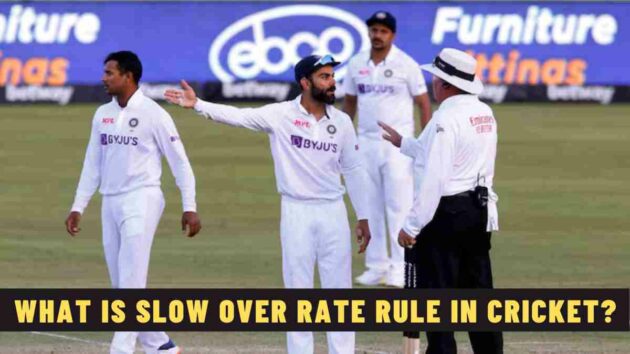If you are a cricket fan, you must have read about a team or a captain incurring a penalty for maintaining a slow over rate in a match.
But what exactly is a slow over rate in cricket?
In this piece, let’s understand the slow over rate rule in cricket.
Slow Over Rate Rule in Cricket
You see, cricket is played in 3 different formats — Test, ODI, and T20. Cricket matches in each format need to be completed within the stipulated time.
Thus, cricket’s global governing body — the International Cricket Council — brought the slow over rate rule into the picture. Under the said rule, the bowling team needs to bowl a set number of overs within a fixed time period.
For instance, in Test cricket, a day’s play lasts for a minimum of 90 overs, which means 30 overs per session. Each session spans 2 hours and the ICC expects bowling teams to bowl a minimum of 15 overs per hour.
If the bowling team adheres to the minimum over rate of 15 overs, then they can complete the 90 overs within the allocated time.
The same rule is applied to ODIs and T20Is, with a tweak in the minimum overs required to bowl. In ODI cricket, a bowling side needs to send down 14.28 overs per hour, while in the T20 format, the bowling team must bowl 14.11 overs per hour.
What happens if a team doesn’t comply with the minimum over rate?
In that case, the match referee will impose a penalty on the team’s captain or every team member.
If a team incurs a slow over rate penalty, the captain and other players are fined a percentage of their match fees. If the same team repeats the offence, the captain might be banned for a few matches.
Moreover, the governing body has introduced in-match penalties in ODIs and T20s for failing to maintain complete overs within the allocated time.
If the fielding team fails to bowl the complete quota of overs within the stipulated time, then they will be asked to field with only 4 fielders outside the 30-yard circle for the rest of the innings.
Also Read | Why are Only 2 Fielders Allowed Behind Square Leg?
Why is the slow over rate rule imposed in cricket?
The intention behind implementing the slow over rate rule is simple. To keep up the pace of a cricket match.
Some teams might intentionally waste time tinkering with a potential match result. The ICC doesn’t want any team to take any unfair advantage by wasting time and derailing the match proceedings.
However, there have been some exceptions that don’t count towards time-wasting or slow over rates.
In the following circumstances, a team is given time allowances:
- Injured player getting treatment on the field
- Injured player leaving the field
- Players or umpires taking reviews
- Time lost due to the batting team
- Drinks break during the innings
- Time allowance after each wicket falls
- Any other situations that are out of control of the bowling side
The slow over rate refrains teams from taking any undue advantage and holds all the players accountable to maintain the spirit of the game.
Read Next | What is Timed Out Dismissal in Cricket?











